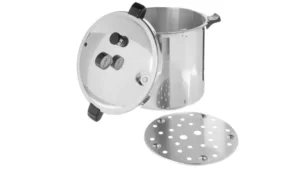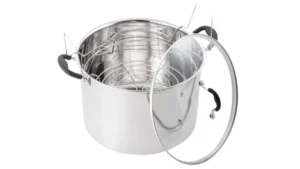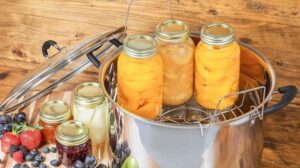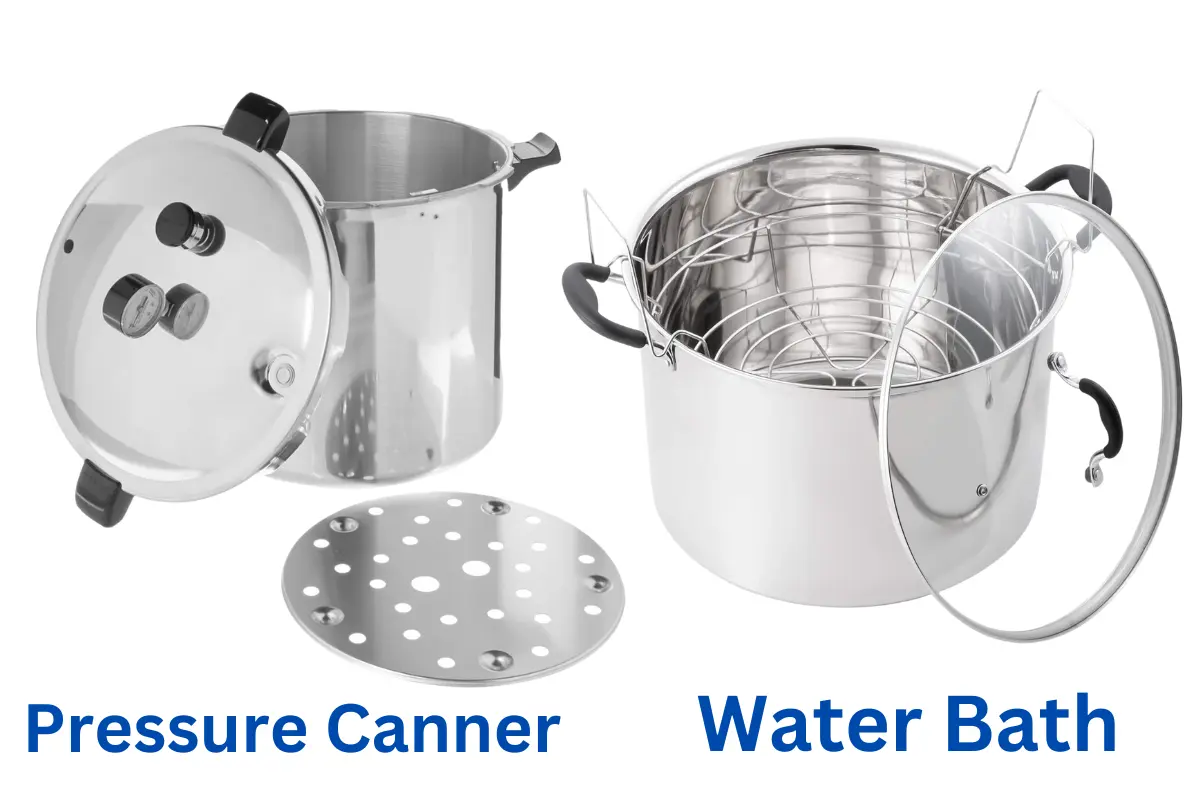Preserving food is a time-honored tradition. Many choose between pressure canning and water bath methods.
Both pressure canners and water bath canners serve a crucial role in home food preservation, but they do so in different ways. Understanding these differences is key to selecting the right method for your canning needs. Pressure canning uses steam under high pressure to kill bacteria in low-acid foods, while water bath canning relies on boiling water to seal jars and preserve high-acid foods.
Each method has its own set of guidelines and is suitable for different types of food. This comparison is not just about safety; it’s about finding the best fit for your culinary projects. Knowing which to use can affect the taste, texture, and shelf life of your home-canned goods. Let’s dive into the world of home preservation and explore the nuances that make pressure canners and water baths unique in their functions.
Pressure Canner vs Water Bath Basics
Choosing between a pressure canner and water bath can be tricky. Each has its own way of preserving food. Let’s dive into the basics of a pressure canner first. This tool is essential for canning low-acid foods safely. Understanding how it works will help you make the right choice for your canning needs.
What Is A Pressure Canner?
A pressure canner is a kitchen gadget designed for home canning. Unlike water baths, it can safely can low-acid foods. These include:
- Vegetables
- Meats
- Poultry
- Seafood
It uses steam under high pressure to kill harmful bacteria. This ensures your canned goods are safe to eat. A pressure canner has a few key parts:
| Part | Function |
|---|---|
| Lid | Seals the canner, keeping steam inside |
| Pressure Gauge | Measures the pressure inside the canner |
| Rack | Holds jars off the bottom of the canner |
Using a pressure canner correctly is crucial. It ensures your canned foods are both safe and tasty.
Pressure Canner vs Water Bath: How It Works
To understand how a pressure canner works, think of it as a big pot with a special lid. This lid locks on tightly. When you heat the canner, water inside turns to steam. This steam increases the pressure inside the canner.
Here’s a simple breakdown:
- Fill the canner with a few inches of water.
- Place filled jars on the rack inside the canner.
- Lock the lid in place and heat on the stove.
- Steam forms, increasing pressure inside the canner.
- High pressure cooks the food in the jars and kills bacteria.
The key to safe canning is maintaining the right pressure. This kills harmful bacteria without overcooking your food. A pressure canner does this efficiently, making it a valuable tool for home canning.

Water Bath Method
Preserving food is a craft as ancient as time itself, and modern methods like pressure canning and water bath canning make it safer and more efficient than ever. The Water Bath Method is a popular choice for many home canners due to its simplicity and effectiveness. It involves submerging jars filled with food in boiling water to seal them airtight, keeping food fresh for longer. Let’s dive into the details of water bath canning and explore the types of food best suited for this method.
What Is Water Bath Canning?
Water bath canning is a home preservation technique used to process high-acid foods. This method utilizes a large pot filled with boiling water to completely submerge jars sealed with tight-fitting lids.
Here’s how it works:
- Jars are filled with prepared food and a bit of acid, like lemon juice or vinegar.
- The filled jars are placed into the canning rack inside the pot.
- Water is added to the pot, covering the jars by at least one inch.
- The water is brought to a rolling boil, and the jars are processed for a specific time.
- Once done, jars are removed and left to cool, allowing the lids to seal from the vacuum created by the cooling contents.
Key Benefits:
| Benefit | Description |
|---|---|
| Easy to Use | No special equipment needed beyond a large pot and canning jars. |
| Safe | Ideal for high-acid foods which are less prone to bacteria like botulism. |
| Energy Efficient | Uses less energy compared to pressure canning. |
Water bath canning is ideal for beginners and those looking to preserve fruits, jams, jellies, and other acidic foods.
Suitable Foods
Not all foods are created equal when it comes to water bath canning. The method is most effective for high-acid foods. This is due to their natural acidity level, which helps prevent the growth of harmful bacteria.
Here are some of the best candidates for water bath canning:
- Fruits like peaches, pears, and apples
- Acidic tomatoes with added lemon juice or vinegar
- Pickles and relishes
- Jams, jellies, and marmalades
- Fruit syrups and pie fillings
- Chutneys and vinegars
- Salsas with proper acidification
Note: Foods like meats, poultry, seafood, and low-acid vegetables require pressure canning to be safely preserved due to their lower acidity levels.
Here’s a simple table to help identify suitable foods for water bath canning:
| Food Type | Acidity | Additional Acid Needed? |
|---|---|---|
| Fruits | High | No |
| Tomatoes | Borderline | Yes |
| Pickles | High (with vinegar) | No |
| Jams and Jellies | High | No |
Remember, following trusted recipes and adding acid when needed keeps your canned goods safe to eat. The water bath method is a great way to start your canning journey and enjoy the flavors of the season all year long!

Safety Considerations
When deciding between a pressure canner and a water bath, understanding safety considerations is crucial. Properly preserving food ensures it’s safe to eat and prevents foodborne illnesses. This section will dive into two important safety aspects: botulism risk and temperature control.
Botulism Risk
Botulism is a serious illness caused by a toxin produced by the bacteria Clostridium botulinum. This bacteria thrives in low-acid environments, making certain foods particularly risky.
- Low-acid foods: These include meats, poultry, seafood, and most vegetables. Pressure canning is necessary for these foods to prevent botulism.
- High-acid foods: These include fruits, pickles, and tomatoes. Water bath canning is usually safe for these foods.
Pressure canners reach temperatures of 240-250°F (115-121°C), sufficient to kill Clostridium botulinum spores. Water bath canners only reach the boiling point of water, 212°F (100°C), which isn’t enough to kill these spores in low-acid foods.
Here’s a quick comparison:
| Food Type | Pressure Canner | Water Bath |
|---|---|---|
| Low-acid foods | Safe | Unsafe |
| High-acid foods | Safe | Safe |
Using the correct method is essential. Incorrect canning can lead to botulism, which can be fatal.
Temperature Control
Temperature control is another key factor in safe canning. Consistent, accurate temperatures ensure all bacteria are killed, preserving food safety.
Pressure canners:
- Equipped with gauges or dials to monitor pressure.
- Allow for precise temperature control.
- Essential for low-acid foods to reach the necessary 240-250°F (115-121°C).
Water bath canners:
- Rely on the boiling point of water.
- Simpler, but less precise compared to pressure canners.
- Suitable for high-acid foods which only need to reach 212°F (100°C).
While pressure canners offer better temperature control, they require more attention and maintenance. Water bath canners are easier to use but are limited to high-acid foods.
Here’s a quick guide:
| Canner Type | Temperature Range | Usage |
|---|---|---|
| Pressure Canner | 240-250°F (115-121°C) | Low-acid foods |
| Water Bath Canner | 212°F (100°C) | High-acid foods |
Choosing the right method and maintaining proper temperatures is vital. It ensures food safety and prevents health risks.

Credit: athomeonthehomestead.com
Efficiency Comparison
When it comes to preserving food, choosing the right equipment is crucial. Both pressure canners and water baths are popular methods, but they differ in efficiency. Let’s dive into how these two stack up in terms of time taken and batch size, helping you make an informed decision for your canning needs.
Time Taken
Time is a valuable commodity, especially in the kitchen. Here’s a closer look at how pressure canners and water baths compare:
- Pressure Canners: These are the speed demons of canning. They use steam under pressure to reach higher temperatures than boiling water. This means they can process jars much faster, especially for low-acid foods that need more time to become safe for storage. You’re looking at about 20 to 100 minutes, depending on what you’re canning.
- Water Baths: A more leisurely pace is the hallmark of water bath canning. It’s ideal for high-acid foods like fruits, pickles, and jams. A water bath typically takes longer, anywhere from 10 minutes to several hours, based on the recipe and jar sizes.
| Method | Approximate Processing Time |
|---|---|
| Pressure Canner | 20 – 100 minutes |
| Water Bath | 10 minutes – several hours |
Remember, a pressure canner’s time efficiency is a clear winner for large batches or low-acid foods. For simpler, smaller tasks, the water bath method might be just fine.
Batch Size
The amount you can process at one time is another key factor. Let’s break down the batch size capacity:
- Pressure Canners: They often have more space, letting you stack jars or fit larger ones inside. This means you can handle bigger batches, which is great for large harvests or meal prepping. It’s a real time-saver when you have a lot to preserve.
- Water Baths: These are typically more limited in size. You might be able to fit several jars in, but usually not as many as a pressure canner. This is fine for small-scale canning or if you’re working with limited quantities.
Think about your needs. If you plan to can in large quantities, a pressure canner’s larger capacity will be more efficient. For those who can in smaller batches or have limited storage space, a water bath could be the better choice.
Cost Analysis
Choosing between a pressure canner and a water bath for preserving food is a big decision. Let’s talk about the costs. Knowing what each method might cost you can help you decide.
Equipment Investment
First, let’s look at the initial cost of getting started. Both methods need some equipment, but the prices vary.
- Pressure Canner: This is pricier. It can cost from $100 to $300 or more. It’s because they are made to handle high pressure and temperature.
- Water Bath: A simpler and cheaper option. You might spend $20 to $80. A large pot with a lid and a rack is mainly what you need.
Here’s a simple table to compare:
| Equipment | Cost Range |
|---|---|
| Pressure Canner | $100 – $300+ |
| Water Bath | $20 – $80 |
Choosing a water bath can save money at the start. But, think about what you’ll can. Pressure canners are a must for meats and vegetables. They keep food safe.
Operating Costs
Next, let’s dive into the costs of using each method.
- Energy Use: Pressure canners need more energy. They have to reach higher temperatures and maintain them. Water baths use less energy since they work at boiling water temperature.
- Jars and Lids: Both methods need jars and lids. But, the cost doesn’t change much between them. You can reuse jars many times but need new lids for each use.
Here’s a breakdown:
- Energy cost for pressure canning: Higher
- Energy cost for water bath: Lower
- Jars and lids: Similar for both
Remember, using a pressure canner might cost more in energy. But, it can handle a wider range of foods. A water bath uses less energy, making it cheaper for fruits and pickles.
Think about what you’ll preserve most. This will help you decide which method fits your budget better.
Flavor And Texture
When preserving food, the methods used can greatly affect its flavor and texture. Two popular methods are pressure canning and water bath canning. Each has unique benefits and impacts on food quality, with noticeable differences in taste and consistency. Understanding these differences can help you choose the right method for your preserves.
Impact On Food Quality
Pressure canning and water bath canning take different routes to achieve food preservation, and this journey significantly influences the final product’s quality.
Here’s what you need to know:
- Pressure Canning: This method uses high temperatures achieved through pressurized steam. It’s essential for low-acid foods like meats and most vegetables. Pressure canning preserves food in a way that retains more of its original flavor and texture. The intense heat can, however, sometimes soften food more than desired.
- Water Bath Canning: Ideal for high-acid foods such as fruits, pickles, and jams, water bath canning involves submerging jars in boiling water. This method can enhance the sweetness and tanginess of the food while maintaining a firmer texture, but it may not be as effective at preserving the original flavors as pressure canning.
| Method | Temperature | Acid Requirement | Texture | Flavor Retention |
|---|---|---|---|---|
| Pressure Canning | 240-250°F | Low-Acid Foods | Softer | Higher |
| Water Bath Canning | 212°F | High-Acid Foods | Firmer | Varies |
While pressure canning typically results in a cooked flavor profile, akin to commercially canned foods, water bath canning can preserve the fresh taste of the harvest, particularly with fruits and pickles. Ultimately, the choice between pressure canning and water bath canning should consider the type of food and the desired outcome in flavor and texture.
Preservation Effects
Preserving food is not just about maintaining taste; it’s also crucial for safety and longevity. The effects of pressure canning and water bath canning on food preservation are distinct:
- Pressure Canning: By reaching higher temperatures, pressure canning destroys more bacteria, yeasts, and molds. This method extends the shelf life of food and makes it safe to store for longer periods. Its ability to preserve low-acid foods is unmatched by water bath canning.
- Water Bath Canning: This method is effective for acid-rich foods that naturally inhibit some microbial growth. While it can keep food safe and tasty for a good amount of time, it doesn’t have the same sterilizing power as pressure canning. Therefore, shelf life might be shorter, and careful attention to acidity levels is crucial.
Both methods require proper sealing of jars to prevent contamination. However, due to the rigorous process, pressure-canned foods often have a more reliable seal. This contributes to their longevity and safety.
When deciding between the two methods, consider the type of food and how long you intend to store it. For long-term storage of low-acid foods, pressure canning is the safer bet. For high-acid foods that you plan to enjoy sooner, water bath canning could be your preferred choice.
Here’s a quick look at the preservation effects:
| Method | Microbial Destruction | Shelf Life | Safety for Low-Acid Foods | Reliability of Seal |
|---|---|---|---|---|
| Pressure Canning | High | Long | Safe | Strong |
| Water Bath Canning | Moderate | Varies | Not Suitable | Good |
By understanding these nuances, you can ensure your preserved foods are not only delicious but safe and durable. Whether it’s the robustness of pressure-canned beans or the bright zest of water-bath-canned pickles, each method has its place in your pantry.
User Experience
Choosing between a pressure canner and a water bath canner often boils down to the user experience. Both methods preserve food, but they cater to different needs and skill levels. This section dives deep into the practical aspects of using each type, providing a clear comparison. Whether you’re a seasoned home canner or just starting, understanding the nuances of each canning method will make your preservation journey smoother.

Ease Of Use
When it comes to ease of use, many home canners have strong opinions. Water bath canning is generally seen as the starting point for beginners. Why? It’s simple:
- Only requires a large pot with a lid and a rack.
- Uses boiling water, familiar to most kitchen enthusiasts.
- Great for high-acid foods like fruits and pickles.
On the other hand, pressure canners, while versatile, can intimidate new users:
- More complex with gauges and venting processes to monitor.
- Requires careful attention to pressure and temperature.
- Essential for low-acid foods like meats and vegetables to avoid botulism.
The choice often depends on what you’re canning.
Here’s a quick view:
| Method | Setup | Process | Suitable Foods |
|---|---|---|---|
| Water Bath | Basic kitchenware | Boil jars | Fruits, jams, jellies |
| Pressure Canner | Specialized equipment | Pressure cook jars | Meats, vegetables |
Learning Curve
The learning curve differs significantly between the two canning methods. Let’s break it down:
For water bath canning, the steps are straightforward:
- Prepare your recipe and jars.
- Fill the pot with water and boil.
- Process jars for the required time.
- Cool down and check seals.
It’s a process that’s easy to grasp, even for those new to canning. There’s less risk involved, and it’s more forgiving of small mistakes.
Pressure canning, though, has a steeper learning curve:
- Understand your pressure canner’s mechanics.
- Adjust for altitude differences.
- Monitor the pressure closely during processing.
- Allow the canner to depressurize naturally.
It’s a process that demands more attention to detail. You need to be precise to ensure safety and prevent spoilage. A mistake in pressure canning can mean a batch of food goes bad, or worse, becomes unsafe to eat.
For both methods, practice makes perfect. Start with simple recipes and as your confidence grows, so will your canning repertoire. Remember, patience and attention to detail are your best friends in the world of canning!
Environmental Impact
Choosing between a pressure canner and a water bath affects more than just your food. It also impacts the environment. Let’s explore how these two methods differ in energy use and sustainability. Understanding these aspects can help us make choices that are kinder to our planet.
Energy Consumption
Both pressure canning and water bathing need energy, but in different amounts. Here’s a closer look:
- Pressure canners use high heat and pressure. This method cooks food quickly. It saves energy.
- Water baths need more time to heat. They use more energy to maintain boiling water.
Let’s break it down:
| Method | Energy Use |
|---|---|
| Pressure Canner | Lower |
| Water Bath | Higher |
Choosing a pressure canner can reduce energy consumption. This is good for the environment.
Sustainability
Sustainability is about using resources wisely. It’s important for our planet. Here’s how pressure canning and water bathing stack up:
- Pressure canning preserves food for longer. This reduces waste.
- Water bathing is good for high-acid foods. It uses more water and energy.
Consider these points:
- Longer shelf life means less food waste.
- Using less energy helps reduce carbon footprint.
- Conserving water is crucial for the environment.
Pressure canning is more sustainable. It saves energy, reduces waste, and conserves water. Making mindful choices in food preservation can support a healthier planet.

Credit: ourlittlehomestead.org
FAQs About Pressure Canner vs Water Bath
Which is better, pressure canning or water bath canning?
Pressure canning is better for low-acid foods (like vegetables and meats) as it reaches higher temperatures, ensuring safety by eliminating harmful bacteria. Water bath canning is ideal for high-acid foods (like fruits and pickles) since it’s sufficient to preserve them. Ultimately, the choice depends on the type of food you’re preserving.
Is it better to pressure can tomatoes or water bath?
It’s better to water bath can tomatoes, as they are high in acid. However, if you’re canning low-acid tomato products (like sauces), pressure canning is necessary to ensure safety. Always follow tested recipes for best results.
What cannot be canned in a pressure canner?
You should not can dairy products, oils, or foods with low acid (like most meats, vegetables, and grains) in a pressure canner unless they are part of a tested recipe. Additionally, jams, jellies, and pickles are best suited for water bath canning due to their high acidity.
What are the disadvantages of water bath canning?
The disadvantages of water bath canning include:
- Limited to High-Acid Foods: Only suitable for high-acid foods like fruits, jams, and pickles.
- Longer Processing Times: Can take longer than pressure canning for some items.
- Less Effective Against Spores: Cannot eliminate bacteria that thrive in low-acid foods, which can lead to safety issues if used incorrectly.
- Requires Full Submersion: Jars must be fully submerged, which can be challenging for large batches or tall jars.
Conclusion
Choosing between pressure canners and water baths depends on your needs. Each method suits different foods and safety requirements. Pressure canners work well for low-acid foods, ensuring safety and flavor. Water baths are best for high-acid foods and simpler to use.
Think about what you’ll preserve most. Your decision will also hinge on time, cost, and storage space. Both methods have their place in home canning. They keep food fresh and tasty. Remember, know your ingredients and pick the right method for them.
Happy canning!

